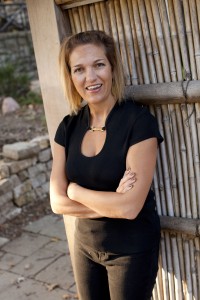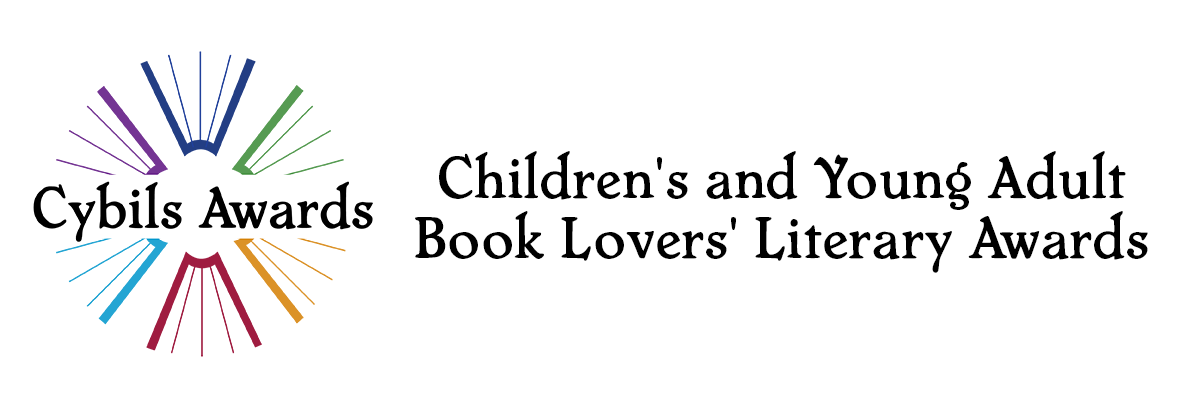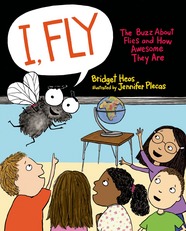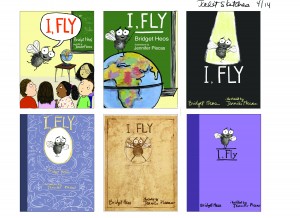First off, congrats! We adored I, Fly. Can you tell us a bit about how you came up with the idea for the book?
Thank you! I’m so honored that CYBILS voters chose I, FLY among all the great nonfiction finalists!
I got the idea for the story when I was walking through my kids’ school and saw that one of the classrooms was studying butterflies. A thought popped into my head: Of course, it’s always the butterflies. And I realized that that was something a fly would say. I thought it would be funny for a fly to try to convince kids to study him, and that a book about this would be a useful addition to butterfly units.
 You’ve written several books about flies and bugs. What interests you about these creatures and what do you want kids to take away from your books?
You’ve written several books about flies and bugs. What interests you about these creatures and what do you want kids to take away from your books?
What I tell kids during my author visits is that we don’t think about how amazing insects are because we see them everyday. But even the fact that a caterpillar becomes a butterfly, and a maggot, a fly, is absolutely incredible. This would be like if a kid went to sleep as a kid, and woke up a bat. That would make front page news! Yet this happens to insects each and every day. If we had no insects here on earth, and then traveled to a distant planet that did have insects, we would see fireflies light up the night sky, tiny flies buzz past us, and butterflies flap their beautiful wings, and think, What is this place? This planet is amazing! Well, that’s OUR planet. And it is amazing. I hope my nonfiction books spark that sense of wonder, or at the very least, make kids laugh.
How do you choose your research topics? Do you do anything differently in researching and writing for different age groups?
Often, an editor will come to me with an idea for a story. Other times, the idea comes from something that surprises me about animals, or a question I have about them. The research is similar for young reader books and big kid books. I read books on the general subject, and then delve into more technical or detailed sources to get to the nitty gritty of the subject. I also talk to experts. Of course, big kid books are longer, and so the research, like everything else, takes a longer time.
You include humor in many of your books, both fiction and nonfiction. Do you find it difficult to include humor in writing nonfiction titles?
The humorous tone comes pretty naturally. I saw a poster in a music classroom once that said, “Be it ever so humble, there’s no voice like your own.” I thought that could apply to a writing voice, as well as a singing voice. My writing voice is definitely more Kermit the Frog than Pavarotti. Jokes do add a new layer to a fact, and you have to make sure that the layer is still accurate. So funny nonfiction books may require an extra step here and there. But then, all nonfiction comes with its own can of worms!
How do you think humor adds to the work?
I think that it gave FLY a point of view that readers can relate to. Not everyone can be a fancy schmancy butterfly. But those of us that are flies are pretty great, too! Jennifer Plecas’s illustrations for this character are just perfect. When I first saw the illustrations, it was like Jennifer had read my mind, even though I’d had no prior notions of what FLY should look like.
Do you think humorous nonfiction is taken less seriously?
Well, I hope so! No, I know what you mean. I think now is a great time to be a nonfiction writer because readers are open to nonfiction as not only a source of facts, but also entertainment and enrichment. At the same time, for a book like I, FLY, the editor, illustrator, and I never lose sight of the fact that certain information needs to be covered. We want kids to be able to use these books for research. We want a book like I, FLY to be useful, and I hope that it is.
If you don’t mind telling us, what are you working on next?
So many things! This year, I have another funny nonfiction title being published by Macmillan: WHO WANTS TO BE A PRINCESS: WHAT IT WAS REALLY LIKE TO BE A MEDIEVAL PRINCESS. Two serious titles are also being released: IT’S GETTING HOT IN HERE: THE PAST, PRESENT, AND FUTURE OF CLIMATE CHANGE (Houghton Mifflin); and BLOOD, BULLETS, AND BONES: THE STORY OF FORENSIC SCIENCE FROM SHERLOCK HOLMES TO DNA (HarperCollins). I also have some fun series nonfiction coming out from Amicus. I’m currently researching pirates. Arrrrr!
Thank you so much for your time!


